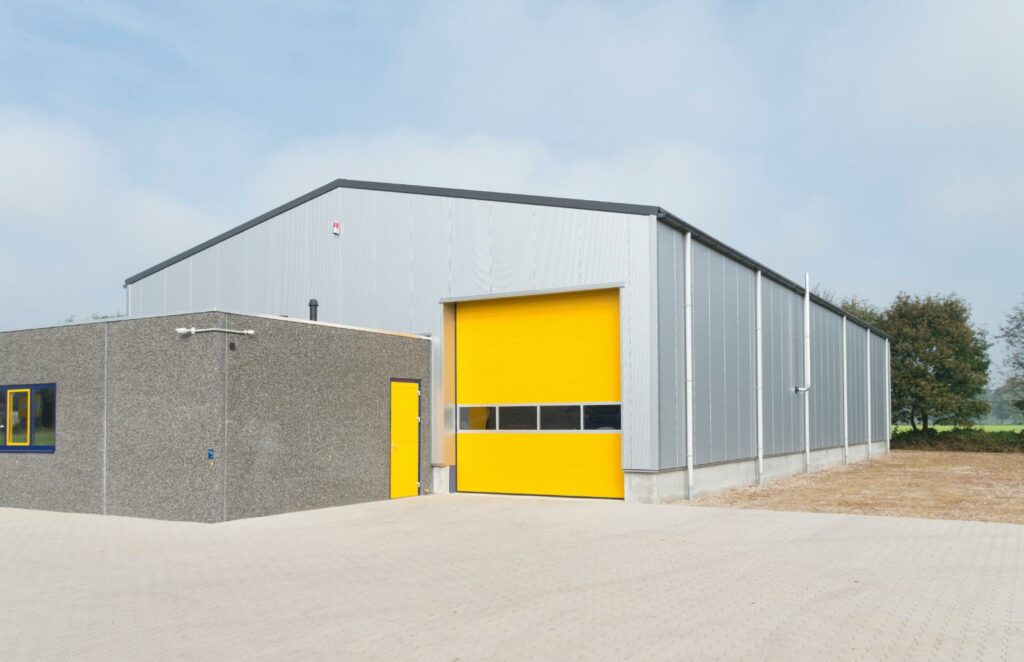
Contents
When it comes to setting up your custom metal garage, simplicity meets meticulous planning. You may think that putting together a metal garage is straightforward, but there are key steps that, when followed efficiently, can make a significant difference in the outcome.
From laying the groundwork to the final finishing touches, each stage plays a crucial role in ensuring the durability and functionality of your metal garage. Stay tuned to discover how small tweaks and smart choices during the setup process can lead to a seamless and well-equipped space for your vehicles and tools.
Key Takeaways
- Proper preparation of the terrain and foundation is crucial for a durable metal garage setup.
- Efficient organization solutions, such as wall-mounted cabinets and modular bins, enhance functionality and space utilization.
- Opting for energy-efficient LED lighting not only saves costs but also ensures optimal brightness in the workspace.
- Careful insulation, ventilation, and electrical setup are essential for maintaining a comfortable and safe environment within the metal garage.
Site Preparation
Before beginning the installation process for your custom metal garage, ensure that the site is adequately prepared to ensure a sturdy foundation. Landscaping considerations play a crucial role in determining the longevity and stability of your garage structure.
Start by assessing the terrain and ensuring it is level. Any unevenness could lead to structural issues down the line. If needed, consider grading the land to create a flat surface for the garage installation. Additionally, take into account the surrounding vegetation and trees. Clear any obstacles that may interfere with the garage, allowing for a safe and accessible space.
Drainage solutions are another vital aspect to address during site preparation. Proper drainage is essential to prevent water accumulation around the garage area, which can lead to erosion and structural damage. Evaluate the natural flow of water on your property and consider implementing solutions such as French drains or gutters to redirect water away from the garage site. By ensuring effective drainage, you can protect your custom metal garage from potential water-related issues in the future.
Foundation Requirements
To ensure the structural integrity and stability of your custom metal garage, precise adherence to specific foundation requirements is essential. When setting up the foundation for your metal garage, two critical aspects to consider are concrete thickness and drainage considerations. The concrete thickness directly impacts the strength and durability of your garage, while proper drainage helps prevent water damage and structural issues in the long run.
Foundation Requirements Table:
| Foundation Aspect | Description | Importance |
|---|---|---|
| Concrete Thickness | The recommended concrete thickness for a metal garage is typically 4 inches to 6 inches. | Ensures structural strength and load-bearing capacity. |
| Drainage Considerations | Proper drainage planning is crucial to prevent water accumulation around or under the foundation. | Protects the foundation from water-related damages. |
Ensuring that the concrete thickness meets the recommended standards will provide sufficient support for your metal garage, ensuring it can withstand various weather conditions and loads. Additionally, incorporating proper drainage considerations will help prevent water from pooling around the foundation, reducing the risk of erosion and water-related damage. By paying attention to these foundation requirements, you can set a solid base for your custom metal garage, enhancing its longevity and structural stability.
Assembly Process
Considering the critical foundation requirements discussed for your custom metal garage, the assembly process involves meticulous steps to ensure structural integrity and stability during installation. To kick off the assembly efficiently, organize all components and tools beforehand, ensuring everything is easily accessible. Utilize efficient techniques such as pre-drilling holes where necessary to streamline the installation process. This not only saves time but also minimizes the risk of errors during assembly.
When erecting the metal framework, follow the manufacturer’s instructions meticulously, as each step is crucial to the overall stability of your garage. Utilizing time-saving strategies like having a second person assist you can significantly reduce assembly time. Additionally, using a level frequently throughout the process ensures that your garage is being assembled correctly, preventing any structural issues down the line.
As you progress to installing the walls and roof panels, make sure to secure each component properly according to the manufacturer’s guidelines. This step is vital to ensure the durability and longevity of your custom metal garage. Finally, after completing the assembly, perform a thorough inspection to confirm that everything is securely in place. By implementing these efficient techniques and time-saving strategies, you can ensure a smooth and successful assembly process for your custom metal garage.
Door Installation
Start the door installation process by carefully reviewing the manufacturer’s instructions to ensure a precise and secure fit for your custom metal garage. Following these steps will help you achieve a successful installation:
Security Features:
Look for doors with robust locking mechanisms to enhance the security of your garage.
Ensure that the door tracks are securely installed to prevent unauthorized access.
Maintenance Tips:
Regularly lubricate hinges and tracks to prevent rust and ensure smooth operation.
Inspect the weather stripping and seals periodically to maintain energy efficiency and keep out dust and pests.
When installing the door, make sure to check that all the parts are included and undamaged. Secure the tracks according to the manufacturer’s guidelines and ensure they’re level and aligned properly. Attach the hinges securely to the door panels before mounting them onto the tracks. Test the door for smooth operation and adjust as needed. Finally, don’t forget to implement any additional security features recommended by the manufacturer to safeguard your belongings.
Following these instructions won’t only result in a well-installed door but also contribute to the overall security and maintenance of your custom metal garage.
Roofing Installation
Begin the roofing installation process by carefully inspecting the materials for any defects or damage before proceeding with the assembly. All metal roofing components must be in good condition to ensure a successful installation. Proper installation techniques are crucial for the longevity and functionality of your custom metal garage. Here are some essential tips to help you with the roofing installation:
Metal Roofing Installation Tips:
| Step | Description | Benefits |
|---|---|---|
| 1. Prepare the Roof | Clean the surface and ensure it is free of debris. | Ensures proper adhesion of metal roofing. |
| 2. Install Underlayment | Lay underlayment to provide additional protection. | Enhances waterproofing and insulation |
| 3. Start at the Eaves | Begin installing metal roofing at the eaves and work upwards. | Ensures proper water drainage. |
| 4. Use Proper Fasteners | Use appropriate fasteners for metal roofing installation. | Prevents leaks and ensures structural integrity. |
| 5. Seal the Edges | Seal all edges and seams to prevent water infiltration. | Enhances weather resistance and durability. |
Insulation and Ventilation
Inspect the insulation and ventilation systems of your custom metal garage to ensure optimal functionality and efficiency. When it comes to insulation selection, choose materials that offer high R-values to provide excellent thermal resistance. Fiberglass insulation is a common choice for its affordability and effectiveness in regulating temperature. Additionally, reflective insulation should be considered to help reduce heat transfer through radiation, especially in hot climates.
For ventilation placement, focus on creating a balanced airflow to prevent moisture buildup and maintain air quality. Install vents near the roof peak to allow hot air to escape while placing intake vents lower to promote air circulation. This setup helps regulate temperature extremes and reduces the likelihood of condensation forming inside the garage.
Proper insulation and ventilation are crucial for creating a comfortable and functional space within your custom metal garage. By carefully selecting insulation materials with high R-values and strategic ventilation placement, you can enhance energy efficiency and ensure a well-ventilated environment. Prioritize these aspects during your garage setup to maximize comfort and usability while belonging to a community that values efficient practices in custom metal garage construction.
Electrical Setup
To ensure the functionality and safety of your custom metal garage, the next crucial step is setting up the electrical system with precision and attention to detail. When it comes to the electrical setup of your garage, two key factors to focus on are the wiring layout and power supply. Ensuring these elements are correctly installed will provide you with a reliable and efficient electrical system for your workspace.
Electrical Setup Guidelines:
| Wiring Layout | Power Supply |
|---|---|
| Plan the wiring layout carefully to avoid overloading circuits and ensure easy access for maintenance. | Choose an appropriate power supply that meets the demands of your tools and equipment. Consider factors such as voltage and current ratings. |
| Use conduit for exposed wiring to protect it from physical damage and follow local building codes for safety compliance. | Install surge protection devices to safeguard your electrical equipment from power surges and fluctuations. |
| Label all circuits clearly to easily identify and troubleshoot any issues that may arise in the future. | Consider investing in energy-efficient LED lighting to reduce electricity costs and enhance visibility in your garage. |
Finishing Touches
When considering the finishing touches for your custom metal garage setup, focus on key aspects such as lighting choices and organization solutions.
Opt for LED lighting to ensure energy efficiency and adequate brightness for your workspace.
Implement storage systems like shelving units and tool cabinets to maintain a clutter-free environment and maximize functionality.
Lighting Choices
Consider selecting LED lighting fixtures for optimal brightness and energy efficiency in your custom metal garage setup. LED lights are energy efficient, providing cost-effective lighting solutions for your space.
Here are some reasons why LED lighting is a great choice:
- Energy Efficiency: LED lights use less energy than traditional incandescent bulbs, saving you money on electricity bills.
- Longer Lifespan: LED lights last longer, reducing the frequency of replacements and maintenance costs.
- Smart Automation Integration: LED lights can be easily integrated into smart automation systems for convenient control and customization.
Make the smart choice for your custom metal garage by opting for LED lighting fixtures that offer both efficiency and cost savings.
Organization Solutions
For a seamless and efficient garage setup, implementing effective organization solutions is essential to maximize space utilization and functionality. Storage solutions play a vital role in keeping your tools and equipment neat and easily accessible. Utilize wall-mounted cabinets, pegboards, and shelving units to declutter the floor space and create a systematic storage system.
Consider incorporating modular storage bins and tool chests to categorize and store small items efficiently. When it comes to workspace design, ensure that your workbench is strategically placed with ample lighting and easy access to power outlets. Utilize overhead storage racks to store bulky items and free up floor space for movement.
Final Thoughts
By following the efficient tips outlined in this article, you can successfully set up your custom metal garage.
Proper site preparation, foundation requirements, assembly process, door and roofing installation, insulation and ventilation, electrical setup, and finishing touches are all crucial steps in creating a functional and durable space for your vehicles and belongings.
With attention to detail and precision, you can achieve a well-organized and efficient custom metal garage setup.
Recent Posts
What Are the Benefits of Tailored Metal Structures?
Imagine a well-crafted suit tailored to fit perfectly; that’s how tailored metal structures operate in
3 Tips for Long-lasting Metal Commercial Structures
When it comes to metal commercial structures, you’ll want to focus on a few key
Explore Benefits of Residential Metal Structures
It’s funny how you might stumble upon the idea of residential metal structures just when




